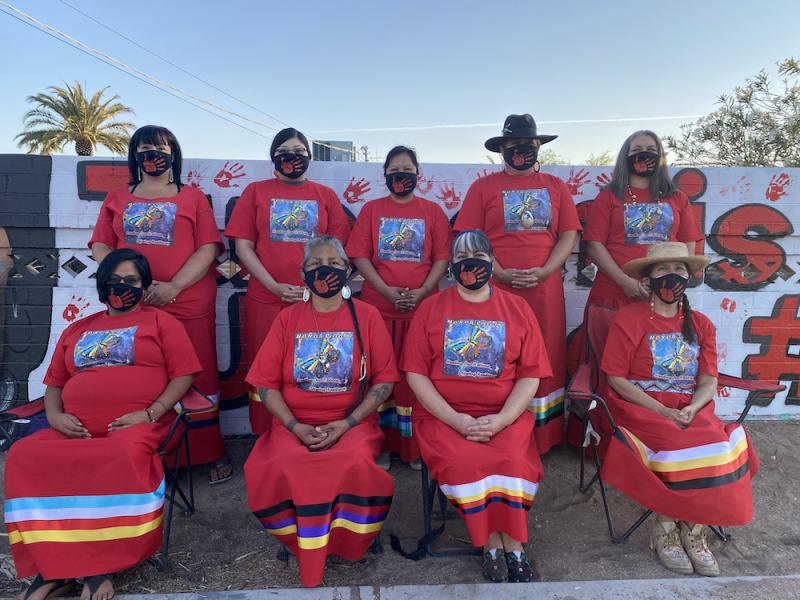Being a Good Neighbor: American Rescue Plan Spotlight on the Arts Foundation for Tucson and Southern Arizona

Arts Foundation for Tucson and Southern Arizona Project Creosote grantee Apache Skateboards Collective pictured in their most recent series titled, Future Intercept, a project that presents Native Futurism and how it affects Native communities. Photo by Douglas Miles Sr.
Adriana Gallego recalled that she joined the Arts Foundation for Tucson and Southern Arizona as executive director during the April 2020 Pink Supermoon. Gallego marked this time with the astronomical phenomenon because it signifies changes, new growth, and adaptability, all of which she has channeled since the beginning of her tenure.
The past two years have not only been the start of something new for Gallego, but for the whole foundation, which has welcomed four new staff members since the beginning of the COVID pandemic. Despite this transitional time, the Arts Foundation, which was recommended for a $500,000 American Rescue Plan (ARP) grant from the National Endowment for the Arts in November 2021, took great strides to fulfill their mission of inclusivity and support for local artists and arts organizations.
The Arts Foundation was incorporated in 1971 to serve Tucson, but over the years has expanded to serve Pima County and the greater Southern Arizona region. This shift reflects the vision of the agency to serve a community and region rich in culture and both urban and rural communities. As a local arts agency, the foundation’s regular activities include managing the public art process for the city and county, providing grant opportunities, and supporting professional development for artists and arts organizations in Tucson and Southern Arizona.
The Southern Arizona creative economy was hit hard by the pandemic. Four months into the pandemic, Tucson ranked third nationally for creative jobs lost in the sector, and at seven months in, the Arts Foundation surveyed 300 local artists and organizations which reported a loss of more than $26 million.
Despite the challenges in 2021, the foundation distributed 500 grants totaling $2.2 million to artists, youth, collectives, and organizations reaching 66 percent first-time applicants, 75 percent BIPOC (Black, Indigenous, and People of Color) grantees in five counties, three Native sovereign nations, and spanning three congressional districts. In the past few years, the foundation has also jumpstarted new programs, including the inaugural AZ Creative Flowers series, a partnership with Unlock Creative for 29 Black women creatives interested in creativity, and reinvented the model for Open Studio Tours as a virtual marketplace with workshops and 40 virtual studio tours.
“It is surely because of the work of my predecessors and the labor of love that they put into this organization and this region for many, many years, and that stressed building programs and basic initiatives that really put Tucson on the map,” said Gallego of her team’s ability to continue supporting the Tucson arts community even in difficult times.
“Tucson is home to thousands of artists, over 200 non-profits, and many more collectives in all disciplines,” added Arts Foundation Communications Manager Jenea Sanchez. “The American Rescue Plan funding is helping us invest in and broadcast all the nuanced and vibrant ways our artistic communities are reinventing occasions for joy, mourning, engagement, and inspiration in spite of insurmountable odds.”
Specifically, this ARP funding will implement year two of a three-year initiative to equitably rebuild arts economies across the border and strengthen community engagement. Project Creosote Rebuilding Grants for those Organizing in the Arts will also invest $450,000 in Southern Arizona’s arts economy with the goal to restore and create jobs, as well as incentivize arts and civic engagement.

Arts Foundation for Tucson and Southern Arizona Project Creosote grantee, HONOR Collective pictured in front of their Murder, Missing Indigenous Relatives awareness mural in Tucson, Arizona. Photo courtesy of HONOR Collective.
Another part of being a good neighbor for the Arts Foundation has meant taking inclusivity and accessibility seriously when encouraging grant applications and from different across communities. Arizona has seven different geographical demarcations from the desert, cactus-dotted landscape in Tucson up to Mount Lemmon, where it’s not uncommon to find snow caps and evergreen trees. The Arts Foundation acknowledges that the diversity of environment is as diverse as the perspectives and experiences of the people who live there, including the Indigenous and Spanish-speaking communities.
“We acknowledge the land where we live and work is traditional land and unceded territory of seven sovereign nations. With that there is a lot of fluidity in terms of boundaries and boarders. The spirit of being able to traverse borders and boundaries is infused with the sense of being a good neighbor,” said Gallego.
To best meet the needs of the state, the Arts Foundation implemented a widespread bilingual marketing approach. Outreach was done across nations through digital newsletters, weekly radio broadcasts, website showcases, social media takeovers and speaking engagements.
“As we reached these smaller communities, our staff really went above and beyond. Sometimes we would transcribe forms through the telephone. It held us to high standards and I was surprised at the large impact our local arts agency could have” said Gallego.
Along with their tenacity, commitment to local communities and the American Rescue Plan grant, the Arts Foundation is looking forward to empowering artists to develop imaginative solutions for the future.
“There is so much that has been possible simply because people have said, ‘yes’ to us and the Arts Foundation. The effects of this national investment in our local economies will scale beyond a one-time relief and we’re all looking toward a new future together,” said Gallego.




